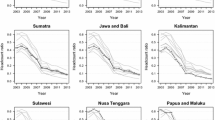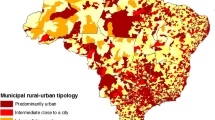Abstract
This paper presents an indicator for measuring multidimensional poverty in the Lao People’s Democratic Republic applying the Alkire–Foster methodology to the Lao Expenditure and Consumption Survey 2002/2003 and 2007/2008. We calculated a multidimensional poverty index (MPI) that includes three dimensions: education, health, and standard of living. Making use of the MPI’s decomposability, we analyse how much each of the different dimensions and its respective indicators contribute to the overall MPI. We find a marked reduction in the multidimensional poverty headcount ratio over the study period, regardless of how the indicators are weighted or how the deprivation and poverty cut-offs are set. This reduction is based on improvements regarding all indicators except cooking fuel and nutrition. We observe no significant reduction in the intensity of poverty, however; there are wide disparities between the country’s regions and between urban and rural areas. The proportion of poor people in rural areas is more than twice as high as that in urban areas. By complementing the traditional income-based poverty measure, we hope to provide useful information that can support knowledge-based decision-making for poverty alleviation.





Similar content being viewed by others
Notes
Although many countries base their official poverty classification on a variety of criteria such as health, education, and access to services, the poverty line is then calculated by estimating the costs of these criteria (Haughton et al. 2009). Thus poverty is in fact measured via a single dimension, i.e. income or consumption. The basic needs approach is one of the most widespread approaches to measuring absolute poverty in developing countries. It measures poverty via a single dimension, i.e. income (often proxied by measuring consumption), by comparing it to an agreed poverty line. This is calculated by estimating the costs of an adequate nutrition and other essentials such as clothing and shelter (Haughton et al. 2009).
The MPI makes it possible to look at joint distribution as opposed to marginal distribution. The relevance of joint distribution in multidimensional analysis was articulated by Atkinson and Bourguignon (1982), who observed that multidimensional analysis is intrinsically different because it is capable of revealing differing degrees of interdependence between dimensions even if the marginal distributions per dimension are identical. Marginal distribution shows how deprivation is distributed within one specific dimension without reference to any other dimension (as in the above-mentioned detailed thematic studies). However, by looking only at the marginal distribution, one does not know who is simultaneously deprived in other dimensions.
A poverty identification of k = 1 is in line with the union approach, which defines poverty as deprivation regarding only one indicator. At the other extreme, k = d corresponds to the intersection approach, which defines poverty as deprivation regarding all indicators at once, meaning that a person is considered poor only if he or she is deprived with regard to all indicators.
According to the classification of Foster (2006), the headcount ratio does not fulfil the dominance axioms of monotonicity and transfer. A poverty measure that does not fulfil these axioms is unsustainable because it encourages policymakers with a limited budget to assist the marginally poor rather than the severely poor.
We considered including the LECS 1997/1998 as well, but decided against it because its method of data collection differed from that used in the later surveys.
The LECS is conducted every five years.
In his blog, Duncan Green, who works as a strategic advisor for Oxfam GB and authored From Poverty to Power, features a discussion on the MPI between its co-creator, Sabina Alkire, and Martin Ravallion of the World Bank. Ravallion criticizes the MPI for being based on normative rather than price-based weights. Alkire responded by arguing that some aspects of poverty are impossible to price (e.g. morbidity, mortality, illiteracy), but giving them zero weight would not seem right either.
For example, market accessibility measured as travel time to towns has a strong positive association with poverty (Epprecht et al. 2008) but is not included in the MPI.
The same is true when other weighting schemes are applied.
Our aim was to test whether the food price increase in 2007/2008 mainly affected non-agricultural urban households. Accordingly, we selected the provinces of Vientiane capital, Vientiane, Xayabury, Borikhamxay, and Champasak, for which Schönenweger et al. (2012) had indicated that food security was at risk; in addition, we selected Phongsaly and Saravane because they have a high proportion of agricultural households (Lao PDR 2012).
We assigned 50 % to the education dimension, with each indicator in this dimension weighing 25 % and the health indicator also weighing 25 %, whereas the indicators of standard of living each received a relative weighting of 4.16 %.
When the health dimension is assigned 50 %, the average intensity (A) rises from 0.53 to 0.65; a 50 % weight for the standard of living dimension leads to a decrease in (A) from 0.53 to 0.45.
References
Alkire, S. (2007a). Choosing dimensions: The capability approach and multidimensional poverty. Chronic Poverty Research Centre Working Paper (88).
Alkire, S. (2007b). The missing dimensions of poverty data: Introduction to the special issue. Oxford Development Studies, 35(4), 347–359.
Alkire, S., & Foster, J. (2007). Counting and multidimensional poverty measures. OPHI Working Paper 7.
Alkire, S., & Foster, J. (2011a). Counting and multidimensional poverty measures. Journal of Public Economics, 95, 476–487.
Alkire, S., & Foster, J. (2011b). Understandings and misunderstandings of multidimensional poverty measurement. Journal of Economic Inequality, 9(2), 289–314.
Alkire, S., & Santos, M. E. (2010). Acute multidimensional poverty: A new index for developing countries. OPHI Working Paper 38.
Atkinson, A. B. (2003). Multidimensional deprivation: Contrasting social welfare and counting approaches. Journal of Economic Inequality, 1(1), 51–65.
Atkinson, A. B., & Bourguignon, F. (1982). The comparison of multi-dimensioned distributions of economic status. Review of Economic Studies, 49(2), 183–201.
Andersson, M., Engvall, A., & Kokko, A. (2005). Determinants of poverty in Lao PDR Working Paper 223. Stockholm: Stockholm School of Asian Studies, Stockholm School of Economics.
Bertrand, J. (2013). Political change in Southeast Asia. Cambridge: Cambridge University Press.
Bourguignon, F., & Chakravarty, S. R. (2003). The measurement of multidimensional poverty. The Journal of Economic Inequality, 1(1), 25–49.
Duclos, J. Y., Sahn, D. E., et al. (2006). Robust multidimensional poverty comparisons. The Economic Journal, 116(514), 943–968.
Eliste, P., & Santos, N. (2012). Lao People’s Democratic Republic Rice Policy Study. Rome: World Bank, FAO.
Engvall, A. (2006). Ethnic minorities and rural poverty in Lao PDR. Stockholm: Mimeo, Stockholm School of Economics.
Epprecht, M., Minot, N. et al. (2008). The geography of poverty and inequality in the Lao PDR. Swiss National Centre of Competence in Research North-South, Geographica Bernensia.
Fenton, N., Krahn, J., et al. (2010). Household reliance on natural resources in Lao PDR: Some evidence from the LECS surveys. Background paper in Lao PDR Development Report 2010. World Bank, Washington, DC.
Fitoussi, J.-P., Sen, A. K., et al. (2011). Mismeasuring our lives: Why GDP doesn’t add up. The New Press.
Foster, J. (2006). Poverty indices. Poverty, inequality and development (pp. 41–65). Berlin: Springer.
Foster, J., Greer, J., et al. (1984). A class of decomposable poverty measures. Econometrica: Journal of the Econometric Society, 52, 761–766.
Government of Lao People’s Democratic Republic. (2013). The millenium development goals progress report for the Lao PDR 2013. United Nations.
Griggs, D., Stafford-Smith, M., et al. (2013). Policy: Sustainable development goals for people and planet. Nature, 495(7441), 305–307.
Haughton, J. H., Khandker, S. R., et al. (2009). Handbook on poverty and inequality (xxi, 419 p). Washington, DC: World Bank.
Heinimann, A., Hett, C., et al. (2013). Socio-Economic Perspectives on Shifting Cultivation Landscapes in Northern Laos. Human Ecology, 41, 51–62.
Kakwani, N., Datt, G., et al. (2002). Poverty in Lao PDR During the 1990s. Mimeo. Manila: Asian Development Bank.
Karver, J., Kenny, C., et al. (2012). MDGs 2.0: What goals, targets, and timeframe? IDS Working Papers, 398, 1–57.
Lao, PDR. (2012). Lao Census of Agriculture 2010/11 highlights. Steering Committee for the Agricultural Census, Agricultural Census Office.
LSB. (2013). Lao Expenditure and Consumption Survey 2002/3 and 2007/8. Vientiane: L. S. Bureau.
Magnus, A., Anders, E., et al. (2005). Determinants of poverty in Lao PDR. Working Paper 223. Stockholm, Stockholm School of Asian Studies, Stockholm School of Economics.
Messerli, P., Heinimann, A., et al. (2008). Socio-economic Atlas of Lao PDR—An analysis based on the 2005 census. Geographica Bernensia. Bern.
Nussbaum, M. C., Sen, A., et al. (1993). The quality of life. Oxford: Clarendon Press.
Oraboune, S. (2008). Infrastructure (rural road) development and poverty alleviation in Lao PDR.
Ravallion, M. (2011). On multidimensional indices of poverty. Journal of Economic Inequality.
Raworth, K. (2012). A safe and just space for humanity: Can we live within the doughnut? Oxfam Discussion Papers.
Robeyns, I. (2005). Selecting capabilities for quality of life measurement. Social Indicators Research, 74(1), 191–215.
Santos, M. E. (2013). Tracking poverty reduction in Bhutan: Income deprivation alongside deprivation in other sources of happiness. Social Indicators Research, 112(2), 259–290.
Schönenweger, O., Heinimann, A., et al. (2012). Concessions and leases in the Lao PDR: Tacking stock of land investments. Geographica Bernensia. Centre for Development and Environment (CDE), University of Bern: Bern, Vientiane.
Scott, L. (2002). A poverty indicator system for local government. Development Southern Africa, 19(4), 483–501.
Sen, A. (1976). Poverty: An ordinal approach to measurement. Econometrica: Journal of the Econometric Society, 44, 219–231.
Sen, A. (1980). Equality of what? The Tanner Lectures on Human Values, 1, 353–369.
Sen, A. (1982). Choice, welfare and measurement. Oxford: Basic Blackwell.
Sen, A. (1992). Inequality reexamined. Oxford: Clarendon Press.
Sen, A. (2001). Development as freedom. Oxford Paperbacks.
Thorbecke, E. (2007). Multidimensional poverty: conceptual and measurement issues. In N. Kakwani & J. Silber (Eds.), The many dimensions of poverty. New York: Palgrave Macmillan.
UN. (2014). Country profile: Lao People’s Dem. Republic. World Urbanization Prospects, the 2014 revision. http://esa.un.org/unpd/wup/Country-Profiles/Default.aspx
UNDP. (2003). Indicators for monitoring millenium development goals. New York: United Nations Development Program.
Vandemoortele, J. (2011). The MDG story: Intention denied. Development and Change, 42(1), 1–21.
Wagle, U. R. (2014). The counting-based measurement of multidimensional poverty: The focus on economic resources, inner capabilites, and relational resources in the United States. Social Indicators Research, 115, 223–240.
Warr, P. G. (2005). Road development and poverty reduction: The case of Lao PDR, Asian Development Bank Institute.
World Bank, & Department of Statistics. (2009). Poverty in Lao PDR 1992/3–2007/8. Washington, DC: World Bank; Vientiane, Department of Statistics.
WFP Lao PDR. (2008). Food market study and pre liminary household level survey on the impact of higher food prices on the household food security. VAM Unit, United Nations World Food Programme.
Acknowledgments
We acknowledge support from R4D FATE, co-funded by the Swiss National Science Foundation (SNSF), the Swiss Agency for Development and Cooperation (SDC), and the Centre for Development and Environment, University of Bern, Switzerland, as well as from the SDC-funded Lao DECIDE Info project. The authors also wish to thank the Lao Statistics Bureau (LSB) for providing the LECS 2002/2003 and 2007/2008.
Author information
Authors and Affiliations
Corresponding author
Rights and permissions
About this article
Cite this article
Bader, C., Bieri, S., Wiesmann, U. et al. A Different Perspective on Poverty in Lao PDR: Multidimensional Poverty in Lao PDR for the Years 2002/2003 and 2007/2008. Soc Indic Res 126, 483–502 (2016). https://doi.org/10.1007/s11205-015-0900-2
Accepted:
Published:
Issue Date:
DOI: https://doi.org/10.1007/s11205-015-0900-2




